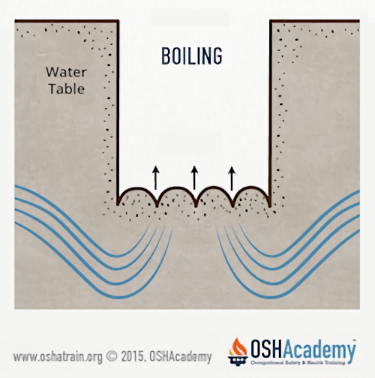Soil Mechanics
Heaving or Squeezing
Bottom heaving or squeezing is caused by the downward pressure created by the weight of adjoining soil.
The weight of adjoining the trench can increase greatly when the soil is wet and it will expand. The expansion increases soil pressure and is a primary cause for the floor of the excavation heaving upward. because there is far less downward pressure under the trench floor. It's a battle of relative pressures. The much greater soil pressure adjoining the trench will cause the uplift in the trench floor.
Heaving and squeezing can occur even when shoring or shielding has been properly installed.
Boiling
Boiling is evidenced by an upward water flow into the bottom of the cut. A high water table is one of the causes of boiling.
Boiling produces a "quick" condition in the bottom of the cut and can occur even when shoring or trench boxes are used.
Heads Up: In 2022's first six months, 22 workers have fallen victim to the deadly hazards present in trenching and excavation work – surpassing 15 in all of 2021 – and prompting the U.S. Department of Labor's Occupational Safety and Health Administration to launch enhanced enforcement initiatives to protect workers from known industry hazards.
Knowledge Check Choose the best answer for the question.
1-4. What causes bottom heaving or squeezing in a trench?
You forgot to answer the question!


